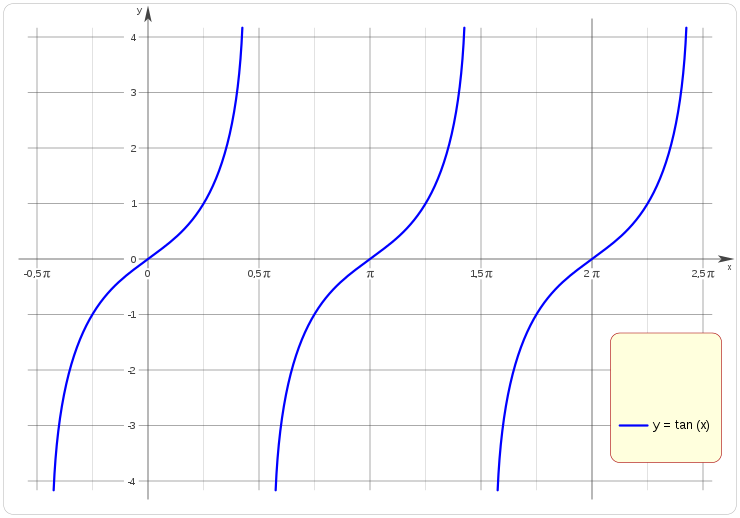En matemática , la tangente es una función impar y es una función periódica de periodo π {\displaystyle \pi } π 2 + n π , n ∈ Z {\displaystyle {\frac {\pi }{2}}+n\pi ,\;n\in \mathbb {Z} } función trascendente de variable real. Su nombre se abrevia de las dos siguientes formas: tan y tg .[ 1]
tg x = − tg ( − x ) {\displaystyle \operatorname {tg} \;x=-\operatorname {tg} (-x)} tg x = tg ( π + x ) {\displaystyle \operatorname {tg} \;x=\operatorname {tg} (\pi +x)} En trigonometría, la tangente de un ángulo (de un triángulo rectángulo ) se define como la razón entre el cateto opuesto y el adyacente:
tg α = a b = B C O C {\displaystyle \operatorname {tg} \alpha ={\frac {a}{b}}={\frac {BC}{OC}}} Esta razón no depende del tamaño del triángulo rectángulo escogido sino que es una función dependiente del ángulo α . {\displaystyle \alpha .}
Esta construcción permite representar el valor del tangente para ángulos no agudos.
Semejanza Dada la circunferencia de radio 1 y una recta r que pasa por el centro, describe un triángulo rectángulo con ángulo α {\displaystyle \alpha }
tg α = C B A C = D E A D = D E 1 = D E {\displaystyle \operatorname {tg} \alpha ={\frac {CB}{AC}}={\frac {DE}{AD}}={\frac {DE}{1}}=DE} El segmento D E {\displaystyle DE} α . {\displaystyle \alpha .}
Representación gráfica Identidades Tangente de la suma de dos ángulos Esta identidad trigonométrica parte de la identidad de la suma de dos ángulos ya conocida para el seno y el coseno.
Dados los ángulos ϕ , θ {\displaystyle \phi ,\theta \ } tg ( ϕ + θ ) = sen ( ϕ + θ ) cos ( ϕ + θ ) {\displaystyle \operatorname {tg} \left(\phi +\theta \right)={\cfrac {\operatorname {sen}(\phi +\theta )}{\cos(\phi +\theta )}}} Reemplazando por las identidades antes mencionadas: tg ( ϕ + θ ) = sen ϕ cos θ + cos ϕ sen θ cos ϕ cos θ − sen ϕ sen θ {\displaystyle \operatorname {tg} \left(\phi +\theta \right)={\cfrac {\operatorname {sen} \phi \cos \theta +\cos \phi \operatorname {sen} \theta }{\cos \phi \cos \theta -\operatorname {sen} \phi \operatorname {sen} \theta }}} Dividiendo al numerador y al denominador por cos ϕ cos θ {\displaystyle \cos \phi \cos \theta \,} tg ( ϕ + θ ) = sen ϕ cos θ + cos ϕ sen θ cos ϕ cos θ cos ϕ cos θ − sen ϕ sen θ cos ϕ cos θ {\displaystyle \operatorname {tg} \left(\phi +\theta \right)={\cfrac {\cfrac {\operatorname {sen} \phi \cos \theta +\cos \phi \operatorname {sen} \theta }{\cos \phi \cos \theta }}{\cfrac {\cos \phi \cos \theta -\operatorname {sen} \phi \operatorname {sen} \theta }{\cos \phi \cos \theta }}}} Separando la suma y la resta y simplificando: tg ( ϕ + θ ) = tg ϕ + tg θ 1 − tg ϕ tg θ {\displaystyle \operatorname {tg} \left(\phi +\theta \right)={\cfrac {\operatorname {tg} \phi +\operatorname {tg} \theta }{1-\operatorname {tg} \phi \operatorname {tg} \theta }}} Tangente de la diferencia de dos ángulos tg ( ϕ + ( − θ ) ) = tg ϕ + tg ( − θ ) 1 − tg ϕ tg ( − θ ) {\displaystyle \operatorname {tg} \left(\phi +(-\theta )\right)={\frac {\operatorname {tg} \phi +\operatorname {tg} (-\theta )}{1-\operatorname {tg} \phi \operatorname {tg} (-\theta )}}} tg ( ϕ − θ ) = tg ϕ − tg θ 1 + tg ϕ tg θ {\displaystyle \operatorname {tg} \left(\phi -\theta \right)={\frac {\operatorname {tg} \phi -\operatorname {tg} \theta }{1+\operatorname {tg} \phi \operatorname {tg} \theta }}} Fórmula resumida tg ( ϕ ± θ ) = tg ϕ ± tg θ 1 ∓ tg ϕ tg θ {\displaystyle \operatorname {tg} \left(\phi \pm \theta \right)={\frac {\operatorname {tg} \phi \pm \operatorname {tg} \theta }{1\mp \operatorname {tg} \phi \operatorname {tg} \theta }}} Tangente del ángulo doble Partiendo de
tg ( ϕ + θ ) = tg ϕ + tg θ 1 − tg ϕ tg θ {\displaystyle \operatorname {tg} \left(\phi +\theta \right)={\frac {\operatorname {tg} \phi +\operatorname {tg} \theta }{1-\operatorname {tg} \phi \operatorname {tg} \theta }}} y haciendo ϕ = θ {\displaystyle \phi =\theta \,}
tg ( 2 ϕ ) = 2 tg ϕ 1 − tg 2 ϕ {\displaystyle \operatorname {tg} \left(2\phi \right)={\frac {2\operatorname {tg} \phi }{1-\operatorname {tg} ^{2}\phi }}} Tangente del ángulo triple Conociendo la tangente del ángulo ψ, hallar la tangente de 3ψ
tg ( 3 ψ ) = 3 tg ψ − tg 3 ψ 1 − 3 tg 2 ψ {\displaystyle \operatorname {tg} \left(3\psi \right)={\frac {3\operatorname {tg} \psi -\operatorname {tg} ^{3}\psi }{1-3\operatorname {tg} ^{2}\psi }}} Tangente del ángulo mitad Se trata de hallar la tangente de la mitad de θ, conociendo los de θ:
tg θ 2 = sen θ 1 + cos θ {\displaystyle \operatorname {tg} {\frac {\theta }{2}}={\frac {\operatorname {sen} \theta }{1+\cos \theta }}} [ 2]
Derivada de la tangente [ tg ( x ) ] ′ = sec 2 ( x ) {\displaystyle [\operatorname {tg} (x)]'=\sec ^{2}(x)\,} Véase también Referencias y notas ↑ En algunos textos o librerías de programas usan la abreviación tg ↑ Granville et all: Op. cit Enlaces externos
Q1129196 Tangent function / Q1129196 



 Datos: Q1129196
Datos: Q1129196 Multimedia: Tangent function / Q1129196
Multimedia: Tangent function / Q1129196

























![{\displaystyle [\operatorname {tg} (x)]'=\sec ^{2}(x)\,}](https://wikimedia.org/api/rest_v1/media/math/render/svg/fff8eb155c6f7f52899e40e70e24b2fa101795e7)











